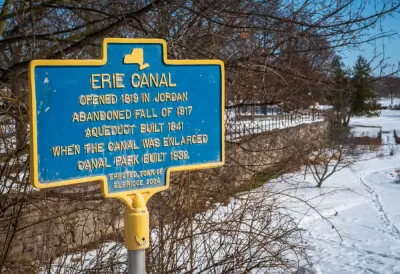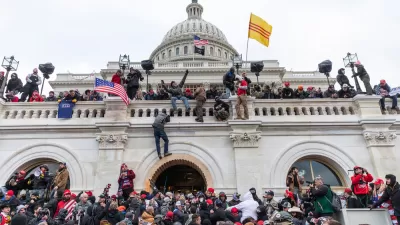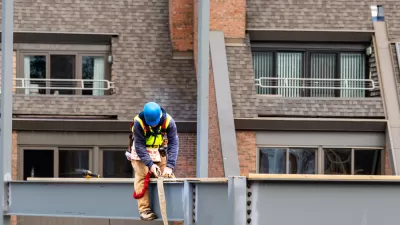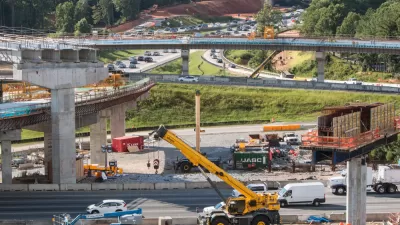The United States has a near perfect track record of building the infrastructure it thinks it needs. But the country and its various state and local governments, don't always get the vision right.

Richard White, professor of American History at Stanford University, documents the uneven history of U.S. infrastructure investments—a note of caution for anyone who imagines that large infrastructure investment programs like those approved during the first 1.5 years of the Covid-19 pandemic or the one currently under consideration in Congress can be a silver bullet for what's ailing the country.
"Over the past two centuries, federal, state and municipal governments across the U.S. have launched wave after wave of infrastructure projects," writes Green.
They built canals to move freight in the 1830s and 1840s. Governments subsidized railroads in the mid- and late 19th century. They created local sewage and water systems in the late 19th and early 20th centuries, and then dams and irrigation systems through much of the 20th century. During World War II, massive amounts of public money were spent building and expanding ports, factories, airfields and shipyards. And after the war, highway construction – long a state and local project – became a federal endeavor.
But, cautions Green, "many of these projects did not end well." According to Green, these failed projects weren't technical failures: "Americans successfully built what they intended, and much of what they built still stands." Rather, these failures were often rooted in the vision and planning processes that preceded the actual work:
The questions about which massive structures to build, and where, are actually very hard to answer. Infrastructure is always about the future: It takes years to construct, and lasts for years beyond that.
Green further characterizes the failures as overbuilding and delayed costs inflicted in projects like the 19th century railroad construction program, Los Angeles' reclamation of water from the Owens Valley, San Francisco's damming of the Tuolumne River in Hetch Hetchy, and the interstate highway system.
Green also offers some advice on how to prevent these kinds of failures in the future:
In promoting infrastructure, politicians will tout jobs, economic growth and a whole array of conveniences and benefits. Citizens should be more sophisticated.
They should ask who – particularly which corporations and developers – are going to benefit from these projects. They should look beyond the price tag to the social and environmental costs. Building canals for a railroad age proved a great mistake. But climate change makes building an infrastructure for a carbon economy a far more dangerous endeavor.
Those pointed words, coming at the conclusion of the article, echo the sentiments of many critics of the Infrastructure Investment and Jobs Act, approved earlier this month by the U.S. Senate and headed to the House of Representatives for final consideration as part of a budget reconciliation package. The bill promises record investments in low-carbon transportation and renewable energy, matching that ambition with increased levels of new funding for highway projects. The implied concern of Green's article, then, is that someday Americans might look back on these investments as a failure of planning for the future.
FULL STORY: U.S. History Shows Spending on Infrastructure Doesn’t Always End Well

Study: Maui’s Plan to Convert Vacation Rentals to Long-Term Housing Could Cause Nearly $1 Billion Economic Loss
The plan would reduce visitor accommodation by 25,% resulting in 1,900 jobs lost.

North Texas Transit Leaders Tout Benefits of TOD for Growing Region
At a summit focused on transit-oriented development, policymakers discussed how North Texas’ expanded light rail system can serve as a tool for economic growth.

Why Should We Subsidize Public Transportation?
Many public transit agencies face financial stress due to rising costs, declining fare revenue, and declining subsidies. Transit advocates must provide a strong business case for increasing public transit funding.

How to Make US Trains Faster
Changes to boarding platforms and a switch to electric trains could improve U.S. passenger rail service without the added cost of high-speed rail.

Columbia’s Revitalized ‘Loop’ Is a Hub for Local Entrepreneurs
A focus on small businesses is helping a commercial corridor in Columbia, Missouri thrive.

Invasive Insect Threatens Minnesota’s Ash Forests
The Emerald Ash Borer is a rapidly spreading invasive pest threatening Minnesota’s ash trees, and homeowners are encouraged to plant diverse replacement species, avoid moving ash firewood, and monitor for signs of infestation.
Urban Design for Planners 1: Software Tools
This six-course series explores essential urban design concepts using open source software and equips planners with the tools they need to participate fully in the urban design process.
Planning for Universal Design
Learn the tools for implementing Universal Design in planning regulations.
City of Santa Clarita
Ascent Environmental
Institute for Housing and Urban Development Studies (IHS)
City of Grandview
Harvard GSD Executive Education
Toledo-Lucas County Plan Commissions
Salt Lake City
NYU Wagner Graduate School of Public Service





























